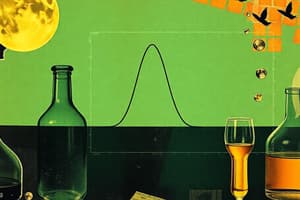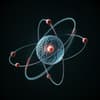Podcast
Questions and Answers
What is the primary purpose of creating a calibration curve using absorbance readings?
What is the primary purpose of creating a calibration curve using absorbance readings?
- To calculate the absorbance of broken glass
- To dispose of waste materials properly
- To establish a control standard for future experiments
- To determine the concentration of the unknown sample (correct)
Which materials should NOT be included in the calibration curve plot?
Which materials should NOT be included in the calibration curve plot?
- 0.5% (w/v) Control Standard (correct)
- Unknown Sample (correct)
- 0.4% (w/v) Calibration Standard
- 0.2% (w/v) Calibration Standard
What is indicated by the target concentration of 0.5% (w/v) for the control standard?
What is indicated by the target concentration of 0.5% (w/v) for the control standard?
- It automatically calibrates the unknown sample measurements.
- It is the exact concentration that must be achieved regardless of measurements.
- It represents the only valid concentration for calibration standards.
- It acts as a reference point for evaluating the calibration curve against absorbance. (correct)
Which statement about the waste disposal process is accurate?
Which statement about the waste disposal process is accurate?
What mathematical representation is required to be included with the calibration curve?
What mathematical representation is required to be included with the calibration curve?
What is the concentration of the Red Dye #40 Calibration Stock Solution (C1)?
What is the concentration of the Red Dye #40 Calibration Stock Solution (C1)?
What is the final volume required for each calibration standard?
What is the final volume required for each calibration standard?
Which pipette is used to add the required amount of Red Dye #40 Calibration Stock Solution into the volumetric flasks?
Which pipette is used to add the required amount of Red Dye #40 Calibration Stock Solution into the volumetric flasks?
What is the purpose of holding the stopper in place with your thumb before mixing the solution?
What is the purpose of holding the stopper in place with your thumb before mixing the solution?
What action should NOT be taken when labeling the volumetric flasks?
What action should NOT be taken when labeling the volumetric flasks?
Which of the following is NOT part of the materials needed for the quantification of unknowns?
Which of the following is NOT part of the materials needed for the quantification of unknowns?
What must be done to each volumetric flask after filling it with the solution?
What must be done to each volumetric flask after filling it with the solution?
What calculation method is used to determine the volume of stock solution required for each calibration standard?
What calculation method is used to determine the volume of stock solution required for each calibration standard?
What is the primary purpose of calibration standards in an analytical chemistry laboratory?
What is the primary purpose of calibration standards in an analytical chemistry laboratory?
In the equation of the line for a calibration curve, which variable represents the instrument response?
In the equation of the line for a calibration curve, which variable represents the instrument response?
How many calibration standards are typically prepared before analyzing unknown samples?
How many calibration standards are typically prepared before analyzing unknown samples?
What is the significance of the slope (m) in the calibration curve equation?
What is the significance of the slope (m) in the calibration curve equation?
What is the rearrangement of the equation y = mx + b to solve for concentration (x)?
What is the rearrangement of the equation y = mx + b to solve for concentration (x)?
What type of data is plotted to create a calibration curve?
What type of data is plotted to create a calibration curve?
What role does the absorbance reading of unknown samples play in analytical chemistry?
What role does the absorbance reading of unknown samples play in analytical chemistry?
What does the R² value of a calibration curve signify?
What does the R² value of a calibration curve signify?
What is the primary purpose of pouring the calibration solutions into the test tubes until they are approximately half full?
What is the primary purpose of pouring the calibration solutions into the test tubes until they are approximately half full?
Which labeling is NOT correct for the test tubes during preparation?
Which labeling is NOT correct for the test tubes during preparation?
What should be done to the spectrophotometer before placing the Blank test tube inside?
What should be done to the spectrophotometer before placing the Blank test tube inside?
How much dH2O should be transferred to the 'Blank' test tube?
How much dH2O should be transferred to the 'Blank' test tube?
What wavelength should the spectrophotometer be set to for optimal measurement of red dye?
What wavelength should the spectrophotometer be set to for optimal measurement of red dye?
After measuring the blank, what is the next action to take regarding the calibration standard?
After measuring the blank, what is the next action to take regarding the calibration standard?
What is the function of pressing the button labelled '0 ABS or 100%T' on the spectrophotometer?
What is the function of pressing the button labelled '0 ABS or 100%T' on the spectrophotometer?
Is it necessary to blank the spectrophotometer between each sample when using the same wavelength?
Is it necessary to blank the spectrophotometer between each sample when using the same wavelength?
What does the variable 'm' represent in the equation of the line?
What does the variable 'm' represent in the equation of the line?
How is the concentration (x) calculated from the absorbance readings (y)?
How is the concentration (x) calculated from the absorbance readings (y)?
What is considered an acceptable range for the percent recovery of a control standard?
What is considered an acceptable range for the percent recovery of a control standard?
What would indicate that the system is considered fit for analysis?
What would indicate that the system is considered fit for analysis?
When calculating the percent recovery, which values are used?
When calculating the percent recovery, which values are used?
In the equation y = mx + b, what does 'b' represent?
In the equation y = mx + b, what does 'b' represent?
What is the correct formula for percent recovery?
What is the correct formula for percent recovery?
What is indicated by the absorbance vs concentration plot?
What is indicated by the absorbance vs concentration plot?
What is required to be added to the calibration curve generated in Excel?
What is required to be added to the calibration curve generated in Excel?
What must be excluded from the calibration curve when plotting absorbance readings?
What must be excluded from the calibration curve when plotting absorbance readings?
Where should broken glass test tubes be disposed of?
Where should broken glass test tubes be disposed of?
What is the target concentration for the control standard in the analysis?
What is the target concentration for the control standard in the analysis?
Which statement regarding the absorbance of the calibration standards is accurate?
Which statement regarding the absorbance of the calibration standards is accurate?
What is the primary function of a control standard in analytical chemistry?
What is the primary function of a control standard in analytical chemistry?
What is considered an acceptable range for the concentration of a control standard after measurement?
What is considered an acceptable range for the concentration of a control standard after measurement?
What should be done if the measured concentration of a control standard falls outside the acceptable range?
What should be done if the measured concentration of a control standard falls outside the acceptable range?
Which of the following statements about the preparation of a control standard is true?
Which of the following statements about the preparation of a control standard is true?
Why is the control standard not included when plotting the calibration curve?
Why is the control standard not included when plotting the calibration curve?
What does the variable 'b' represent in the equation of the line?
What does the variable 'b' represent in the equation of the line?
Which formula should be used to calculate the percent recovery of the control standard?
Which formula should be used to calculate the percent recovery of the control standard?
What range is typically deemed acceptable for the percent recovery of a control standard?
What range is typically deemed acceptable for the percent recovery of a control standard?
In the rearranged equation to solve for concentration (x), which variable represents the slope?
In the rearranged equation to solve for concentration (x), which variable represents the slope?
When plotting absorbance vs concentration for calibration standards, which aspect is NOT required?
When plotting absorbance vs concentration for calibration standards, which aspect is NOT required?
What should be the next action after measuring the blank with the spectrophotometer?
What should be the next action after measuring the blank with the spectrophotometer?
Which of the following indicates the actual concentration of a solution?
Which of the following indicates the actual concentration of a solution?
What is the primary purpose of the control standard in this analysis?
What is the primary purpose of the control standard in this analysis?
What is the correct volume to transfer to each labeled test tube during preparation?
What is the correct volume to transfer to each labeled test tube during preparation?
Why is it important to ensure the outside of the test tube is clean before using the spectrophotometer?
Why is it important to ensure the outside of the test tube is clean before using the spectrophotometer?
What should be done after placing the BLANK test tube in the spectrophotometer?
What should be done after placing the BLANK test tube in the spectrophotometer?
Which of the following should be labeled on the test tubes during preparation?
Which of the following should be labeled on the test tubes during preparation?
What is the primary role of the spectrophotometer when analyzing the prepared solutions?
What is the primary role of the spectrophotometer when analyzing the prepared solutions?
What is the optimal wavelength setting on the spectrophotometer for measuring red dye?
What is the optimal wavelength setting on the spectrophotometer for measuring red dye?
Which action is unnecessary when analyzing samples if the wavelength remains unchanged?
Which action is unnecessary when analyzing samples if the wavelength remains unchanged?
How should the test tubes be filled to ensure accurate measurement of absorbance?
How should the test tubes be filled to ensure accurate measurement of absorbance?
What does the slope (m) represent in the calibration curve equation?
What does the slope (m) represent in the calibration curve equation?
In the context of a calibration curve, what is the importance of the R² value?
In the context of a calibration curve, what is the importance of the R² value?
When calculating the concentration (x) of an unknown from absorbance (y), which equation is used?
When calculating the concentration (x) of an unknown from absorbance (y), which equation is used?
What must be prepared before measuring the absorbance of unknown samples?
What must be prepared before measuring the absorbance of unknown samples?
How is the absorbance reading of an unknown sample used after calibration?
How is the absorbance reading of an unknown sample used after calibration?
What is the primary role of calibration standards in analytical chemistry?
What is the primary role of calibration standards in analytical chemistry?
What does the variable 'b' represent in the equation of the line for a calibration curve?
What does the variable 'b' represent in the equation of the line for a calibration curve?
Which action is crucial before taking absorbance readings with a spectrophotometer?
Which action is crucial before taking absorbance readings with a spectrophotometer?
Flashcards are hidden until you start studying
Study Notes
Introduction
- Spectrophotometers are used in analytical chemistry to measure the amount of an analyte in a sample
- Absorbance readings are obtained from spectrophotometers
- Calibration standards are solutions with known concentrations of the analyte
- Calibration curves plot the absorbance readings of a set of calibration standards against their corresponding known concentrations
Calibration Curve and Equation of the Line
- Calibration curves facilitate the determination of the concentration of an analyte
- Calibration curves can be plotted using Microsoft Excel
- Absorbance data for calibration standards is plotted to generate a calibration curve
- A linear trendline is fitted to the plotted data
- The equation of the line for the calibration curve is in the form y = mx + b
- y = instrument response (e.g, absorbance), x = analyte amount (e.g., concentration), m = slope of the calibration curve, and b = y intercept
- The equation of the line is used to determine the concentration of unknown samples
Materials
- 40% (w/v) Red Dye #40 Calibration Stock Solution
- 0.5% (w/v) Red Dye #40 Control Standard
- Red Dye #40 Unknown Sample
- Distilled water
- Spectrophotometer
- 1000 µL micropipettes and tips
- Volumetric flasks (4x 25mL)
- Stoppers (4x)
- Test tubes (7x Size: 13x100mm)
Calibration Standard Preparation
- The calibration standards are prepared using the 40% (w/v) Red Dye #40 Calibration Stock Solution
- The calibration standards are prepared in volumetric flasks
- The target concentrations of the calibration standards are 0.2%, 0.4%, 0.6%, and 0.8% (w/v)
- The volume of each calibration standard is 25 mL
- The formula C1V1 = C2V2 is used to calculate the volume of calibration stock solution needed for each concentration
- Each volumetric flask is filled with distilled water approximately halfway
- The calculated volume of stock solution is added to each flask using a micropipette
- Each flask is filled to the 25 mL mark with distilled water
- Each flask is capped and mixed by inverting several times
- Four test tubes are labeled with the concentrations of the calibration standards (0.2%, 0.4%, 0.6%, and 0.8%)
- Each calibration solution is transferred to the corresponding test tube
Additional Standard/Sample Preparation
- Three additional test tubes are labeled: ‘Blank’, ‘0.5% Ctrl’, and ‘Unknown’
- The ‘Blank’ test tube is filled with distilled water
- The ‘0.5% Ctrl’ test tube is filled with the 0.5% (w/v) Red Dye #40 Control Standard
- The ‘Unknown’ test tube is filled with the Red Dye #40 Unknown Sample
Spectrophotometer Analysis
- The spectrophotometer wavelength must be set to 500 nm
- The ‘Blank’ test tube is measured in the spectrophotometer and the absorbance is set to zero
- The remaining test tubes are analyzed individually in the spectrophotometer
- The absorbance readings are recorded for all test tubes
Waste Disposal
- Liquid waste is disposed of in a waste container in the fume hood
- Glass test tubes are disposed of in the broken glass only container
- Dispose of all chemicals according to the safety regulations
Data Analysis
- A calibration curve is plotted in Excel using the absorbance readings of the calibration standards
- The absorbance values of the ‘Unknown’ and ‘Control Standard’ are not included in the calibration curve
- A linear trendline is added to the calibration curve
- The equation of the line is determined
- The equation of the line is used to calculate the concentration of the ‘Unknown’ and ‘Control Standard’
- The percent recovery of the ‘Control Standard’ is calculated
- Acceptable recovery ranges between 80-120%
- If the control standard recovery falls within this range, the system is considered fit for analysis
Results Summary Requirements
- Each group submits one PDF document containing two pages
- Page 1: (1) Calibration curve plot (5 marks) and (2) Summary table of absorbance readings (1 mark)
- Page 2: (1) Concentration calculations for the ‘Unknown’ and ‘Control Standard’
Introduction
- Spectrophotometers are used to determine the amount of an analyte in a sample by measuring absorbance
- Absorbance readings do not tell us how much analyte is present unless they are related to known values
Calibration Standards
- Calibration standards contain known concentrations of the analyte
- Absorbance readings of calibration standards are measured to relate instrument response to known values
- Calibration standards are prepared by analyzing between 3-5 standards and taking the absorbance readings
Calibration Curves
- A graph of absorbance vs concentration of calibration standards is called a calibration curve
- A linear trendline fitted to the data gives the equation of the line, y=mx+b where:
- m = slope of the line
- b =y intercept
- x = amount of analyte
- y = instrument response
- Equation can be rearranged to solve for concentration of unknown samples: x=(y-b)/m
Control Standard
- Control standard is a separate standard of known concentration prepared from a different source of the analyte
- Control standard is not part of the calibration curve
- The control standard concentration is calculated using the equation of the line and absorbance reading
- A control standard concentration between 80-120% of the expected value indicates that the instrument and calibration standards are working properly and fit for analysis
Spectrophotometer
- Spectrophotometer manufacturer: Agilent
- Spectrophotometer model: Cary 60
- Spectrophotometer SLC number: SLC-1234
Additional Standard/Sample Preparation
- Label test tubes with: Blank, 0.5% Ctrl, Unknown
- Fill each test tube approximately halfway with their respective solution
- Blank: 5 mL dH2O
- 0.5% Ctrl: 5 mL of 0.5% (w/v) Red Dye #40 Control Standard
- Unknown: 5mL of Red Dye #40 unknown sample
Standard/Sample Analysis
- Clean the outside of the test tubes before analysis
- Set the wavelength of the spectrophotometer to 500 nm
- Place the Blank test tube in the spectrophotometer and set absorbance to zero by pressing the button labelled ‘0 ABS or 100% T’
- Replace the Blank with the first calibration standard and close the lid
- Do not re-zero the spectrophotometer between samples
- Record the absorbance readings for all samples
Waste Disposal
- Liquid waste: Dispose in the waste container in the fumehood
- Glass test tubes: Dispose in the bucket labeled ‘Broken Glass Only’
Data Analysis
- Use the ‘Plotting with Excel’ document for guidance
- Plot the absorbance readings of the calibration standards only on a graph. Do not plot the absorbance values for the unknown or control standard.
- Add a linear trendline, equation of the line (y=mx+b), and R2 to your calibration curve
- Calculate the concentration of the Unknown and Control Standard using the equation of the line (y=mx+b)
- Rearrange equation to solve for concentration: x = (y-b)/m
- Calculate the percent recovery of the Control Standard using the formula: (Actual Concentration/Expected Concentration) x 100%
Marking Scheme
- One Blackboard submission per group
- Refer to the ‘Submitting Assignments Via Blackboard’ instructions
- One PDF document containing two pages:
- Page 1:
- Plot of absorbance vs concentration of calibration standards (5 marks)
- Summary table of absorbance readings for calibration standards, unknown, and control standard (1 mark)
- Page 2:
- Concentration calculations for unknown and control standard (6 marks)
- Page 1:
Studying That Suits You
Use AI to generate personalized quizzes and flashcards to suit your learning preferences.





